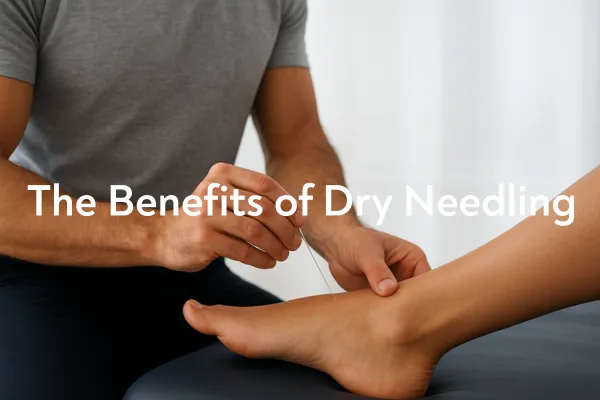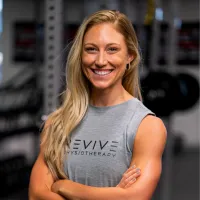Read our Blog

The Benefits of Dry Needling
Benefits of Dry Needling for Muscles and Joint Injuries.
Introduction
Whether you’ve been feeling muscle pain, injuries to your joints or chronic pain, a means to seek effective relief is paramount. Dry Needling therapy is a favorite at Revive Physiotherapy when it comes to managing and healing pain.
Though often mistaken as acupuncture, dry needling is a well-established physiotherapy treatment that involves connecting tight, injured, and irritated tissues with tiny and sterile needles. Dry needling facilitates deep healing and is the foundation of many sports that are pain relievers, mobility enhancers, and recovery accelerators.
In this blog, we’ll be discussing the benefits of dry needling in different conditions, including muscle strains, chronic pain, tendinopathies, nerve injuries, trigger points, and ligament sprains.
How Does Dry Needling Work?
Dry needling is to provide a controlled, micro-level “reset” of injured tissue.
When you insert a thin needle into a muscle or tendon:
It reduces the abnormal electrical activity of the nervous system driving muscle spasms and trigger-point activation. This improves blood flow, oxygen delivery, and nutrient supply to aid injury healing.
It triggers a localized healing response, releasing growth factors and lowering inflammation.
It controls signals of pain in the nervous system and facilitates the release of the mood neurotransmitter endorphins.
Outcome: Less hurt, more movement and quicker recovery of tissue.
1. Dry Needling for Muscle Injuries.
Muscle strains, pulls or tears can cause pain and tightness that don’t really go away. Scar tissue and protective spasms come over the face as the system tries to brace.
Dry-needling therapy assists us in:
Releasing dysfunctional muscle knots.
Restoring circulation so that healing happens more quickly.
Normalizing muscle action is restored.
For athletes and healthy adults, this equals faster return to activity, and less risk of reinjury.
2. Dry Needling for Chronic Pain.
Chronic pain may have both tissue damage and nervous system sensitivity. Stiff muscles, trigger points (inhaling and releasing pain), and reduced circulation.
Dry needling helps these chronic pain sufferers by:
Reducing nerve hyperactivity in sensitized muscles.
Releasing natural endorphins needed to ease pain.
Keeping muscle tone balanced to reduce pressure on joints and nerves.
It’s especially effective with low back pain, neck pain, and tension headaches.
3. Dry Needling for Tendinopathies.
It is important to note that chronic conditions such as tennis elbow, golfer’s elbow, Achilles tendinopathy, and rotator cuff tendonitis are characterized by the degeneration of tendon fibers. Limited blood supply slows down tendon healing.
Dry Needling Is helpful in Tendinopathies:
Encouraging a controlled healing response of degenerated tendons.
Facilitating blood flow to poorly vascularized tissue.
Decreasing pain to allow for progressive exercise therapy.
In conjunction with structured rehabilitation, dry needling can speed pain relief and functional recovery.
4. Dry Needling in Radiculopathy.
Radiculopathy happens when a nerve root is compressed or irritated, usually due to a herniated disc or spinal stenosis. Symptoms may include pain, tingling or weakness that goes down the arms or legs.
Dry needling can alleviate radiculopathy by:
Relaxing tight muscles that would press on the nerve.
Reducing local inflammation.
Modulating pain signals along irritated nerves.
Dry needling is not a cure for structural nerve compression but can alleviate symptoms significantly and improve mobility.
5. Dry Needling: Nerve Damage.
Surrounding muscles at the site of peripheral nerve injuries often weaken or spasm in these patients if a person has an altered nerve physiology function. Dry needling helps with nerve recovery by providing relief from the secondary strain of surrounding muscles. Enhancing circulation around the injured nerve.
This therapy can work well especially in treating nerve muscle pain and general deficiencies in function.
6. Dry Needling For Muscle Spasms and Trigger Points.
Myofascial trigger points — tight, painful bands in muscles — are among the most common applications of dry needling.
Examples include:
Tension headaches caused by upper trapezius trigger points.
Gluteus medius muscle spasms that mimic low back pain.
Dry needling triggers trigger points by:
The initiation of a local twitch response in order to reset abnormal muscle activity.
Cutting down on chemical irritants at the motor end plate near the motor end plate.
Restoring normal muscle length-tension relationships.
Patients will often feel relief from immediate pain and will be able to move easier.
7. Ligament Sprains: Dry Needling.
Ligaments receive less blood than muscles, so after a sprain healing can be slow.
Although dry needling is not a first-line treatment, it can:
Bolster local circulation and decrease swelling.
Relax surrounding protective muscle guarding.
Promote site-specific healing of local connective tissue.
This facilitates recovery and decreases the possibilities of sustained joint instability.
What to Expect During a Dry Needling Session
At Revive Physiotherapy, the typical dry needling session should include:
Assessment: Identify the root cause of pain and limits in movement.
Targeting: Pinpointing muscles, tendons, or tissues to treat.
Treatment: Insert a sterile, thin needle; if there is a slight twitch or ache, that means tissue activation has occurred.
Aftercare: Mild soreness for 24-48 hours, improved movement, less pain.
Integration: Use of dry needling, exercise, manual therapy, load progression for enduring effects.
Why Dry Needling Works Better With Complete Rehab.
The combination with a full rehabilitation program for you, dry needling is best at:
Manual therapy for improved joint and soft tissue mobility.
Strength and conditioning exercises for load tolerance.
Education on posture, movement, and lifestyle strategies to help prevent reinjury.
This whole approach provides long-term treatment (which is far from the quick fix of instant pain reduction) rather than pain relief.
Summary: advantages of dry needling therapy.
Dry needling therapy is versatile and effective for treating:
Muscle injuries.
Chronic pain.
Tendinopathies (e.g., tennis elbow, rotator cuff injury).
Radiculopathy.
Nerve damage.
Muscle spasms and trigger points.
Ligament sprains.
Dry Needling promotes healing, reduces pain, and normalizes muscle and nerve function, all of which helps patients accelerate recovery and reintegrate back into life.
If you are having muscle or joint pain, our firm at Revive Physiotherapy can give you a feel for whether you can do dry needling!
📞 Call us today to schedule your consultation or 💻 book online to be able to proceed with your personalized recovery plan. Don’t just put a mask on the pain—treat it directly, and return to the life you love.
Our one-on-one treatment sessions ensure that you fully understand your body and take ownership of your health so that you can have control over doing the things you love!
Send us a Message
Let's Have a Chat
954 - 519 - 4185
Find us at
2852 E Oakland Park Blvd
Fort Lauderdale, FL 33306
2024 REVIVE PHYSIOTHERAPY | ALL RIGHTS RESERVED


